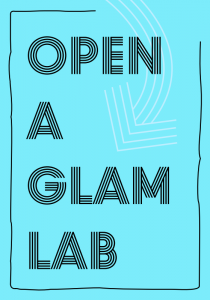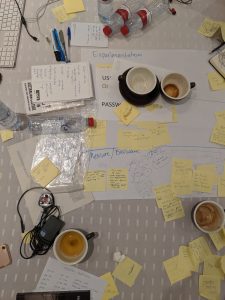LC LABS LETTER
A Monthly Roundup of News and Thoughts from the Library of Congress Labs Team
Keeping up with the Innovators
This month, Brian Foo and Ben Lee came back to the Library to gather feedback from staff in the early stages of their project and to showcase working prototypes.
Brian presented his project Citizen DJ, a music production and sampling tool, which will allow users to produce their own music using public domain audio and sounds from moving image materials.
Ben showed his project Newspaper Navigator, which extracts visual content from the digitized historic newspapers in Chronicling America to allow users to browse it using exploratory modes of search.
Both Ben and Brian will continue meeting with Library stakeholders including curators, outreach units, and counsel to demo their works in progress. They will then move into the next phase of their projects, which will be to begin user testing with broader audiences and to publish their source code.
Keep an eye out on the LC Labs Experiments page, where they will soon begin sharing public versions of their work.
LC Labs Presents at Fantastic Futures, CNI conferences
Earlier this month, acting Labs Chief Meghan Ferriter and Senior Innovation Specialist Abbey Potter co-presented a workshop with staff from Stanford, UC Berkeley, and the National Library of France at Fantastic Futures 2019, an international conference on AI in archives, libraries, and museums. The workshop dove into ethics, what it takes to move an AI project from start to finish, and how to prepare staff for future developments in this technology.
The LC Labs team also presented at the CNI (Coalition for Networked Information) Fall 2019 Meeting this month. Leah Weinryb Grohsgal, Laurie Allen, Jaime Mears, and Meghan Ferriter spoke about the implementation of the Digital Strategy, the recruitment process for the Innovator in Residence program, the maturation of By the People (the Library’s crowdsourcing program) and the team’s goals for the Computing Cultural Heritage in the Cloud project.
Abbey Potter and Eileen Jakeway also shared brief updates about the GLAM Labs Book Sprint and experimenting on supporting digital scholarship, respectively. To read the abstract of both presentations, look them up in the CNI meeting program.
Computing Cultural Heritage in the Cloud: Stay tuned
If you didn’t have a chance to participate in last week’s virtual information session about the Computing Cultural Heritage in the Cloud project, check out this blog post by Senior Innovation Specialist Laurie Allen outlining the history of the grant and its proposed approach to testing researcher access to digital collections at scale through the cloud.
You can also read more about the project, including its advisory board and timeline, on its landing page: //labs.loc.gov/experiments/cchc/.
Curio
- This month, LC Labs and the Innovators in Residence visited the National Audio-Visual Conservation Center at the Library’s Packard Campus in Culpeper, VA. We learned about various types of conservation necessary for preserving audio and visual material and the necessity of caring carefully for nitrate film! Re-live the experience on this live-tweeted thread.
- The “Rosa Parks: In Her Own Words” exhibit opened at the Library of Congress on December 5. It showcases rarely seen materials documenting Parks’ lifelong commitment to activism. If you have a chance, check it out on the second floor of the Jefferson building. If you want to know more but are not local to DC, take a listen to this six-minute documentary highlighting some of her private writings or read them for yourself in the Rosa Parks digital collection.
- The Library of Congress has joined the Digital Preservation Coalition as a full member. Read more on the Signal blog in a post by Digital Projects Coordinator Kate Murray.
- Looking for something fun to do over the holidays? By the People launches a challenge this week focusing on review of Clara Barton’s diaries in celebration of her birthday, December 25. Join at crowd.loc.gov.
Kate’s Corner
Notes from the Director of Digital Strategy
In a few days, I’ll travel to my ancestral homeland for holiday celebrations. My parents’ house will be filled to bursting with the smell of good food and the pleasant chaos of family and friends. It’s big, it’s loud, it’s New Jersey.
As always, there will be a few new people. Walking in on all of this can feel a bit intense. So someone will grab them, give them a hug, and tell them to check on whatever’s in the oven or grab some chairs from the basement. It’s our way of showing without telling, that you’re not just welcome here, you’re family.
The Library’s crowdsourcing program By the People reminds me of that moment. Where you know you belong because someone’s asking for your help, that this dinner is yours because you helped make it.
This time of transition of seasons also brings a new beginning for By the People. It is graduating from pilot to program and moving, along with program community managers, to a new home in the Digital Content Management Section of the Library. LC Labs incubated and nurtured By the People as an experiment in engaging users with our collections. Success, though, means it must move as it transitions to a permanent place in the Library.
In just over a year, the crowd has transcribed and tagged some fascinating materials: an 1849 draft of a bill to abolish slavery in D.C.; handwritten by Abraham Lincoln, Susan B. Anthony’s letter discussing her defense for illegally voting in an 1872 federal election; and baseball scout Branch Rickey’s 1963 assessment that Hank Aaron was “frequently a guess hitter,” despite his power and hitting record.
I’m proud of what we accomplished and grateful to Dr. Hayden for beginning this program. Thank you to all who have contributed. I hope it has helped you know that you are welcome, and you are cherished.
-Kate Zwaard
For more information about LC Labs, visit us at labs.loc.gov
Questions? Contact LC Labs at [email protected]
Sign up to regularly receive our monthly newsletter at //listserv.loc.gov/cgi-bin/wa?SUBED1=LC-LABS&A=1


